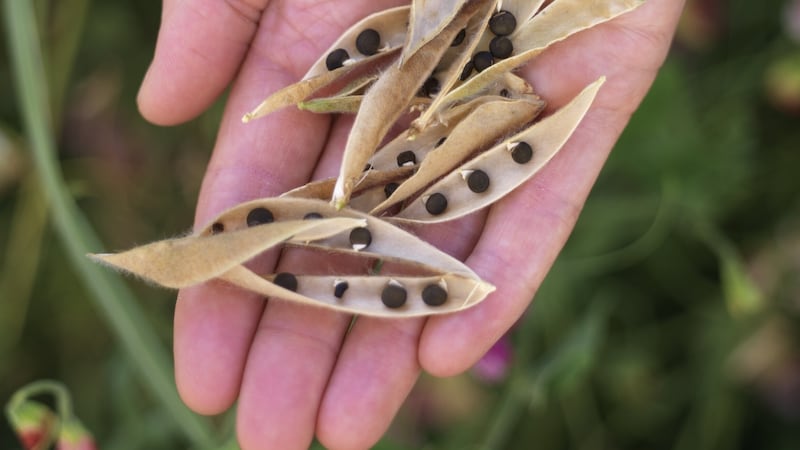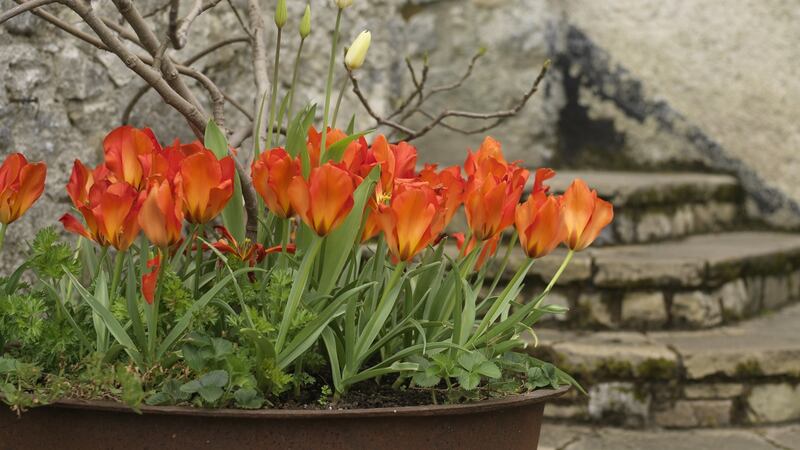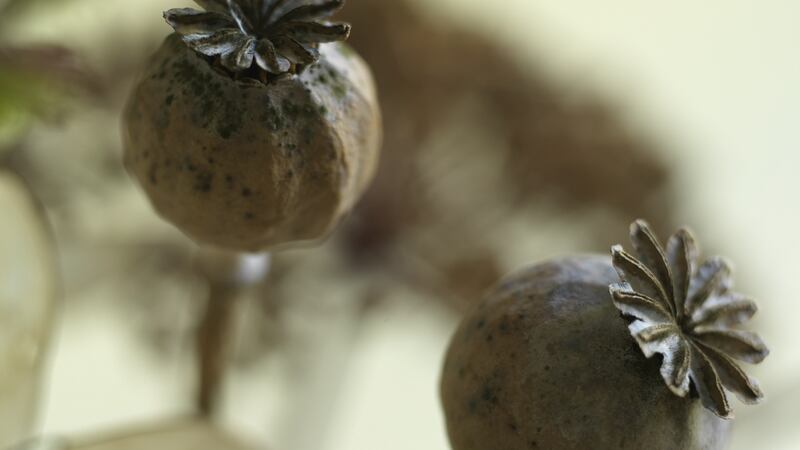Make a lasagne
No, not the edible kind but the horticultural version, using an array of spring-flowering bulbs and a handsome, generous-sized container to give you a successional display of colourful flowers throughout the spring months. The trick is to plant backwards, placing the largest, latest -flowering bulbs on a layer of compost to the bottom of the pot (for example, mid-season and late tulips, daffodils) followed by one or two layers of any of the smaller, earlier flowering bulbs such as snowdrops, crocuses, grape hyacinths, Iris reticulata, Anemone blanda or chionodoxa.
Use a good quality, free-draining compost, leaving 5-6cm of compost between layers and use no more than a maximum of three layers. Dublin-based Mr Middleton (mrmiddleton.com) has a fine range of spring flowering bulbs in stock to choose from as do most good Irish garden centres.
Save some seed

This month Irish gardens and allotments are full of ripe or ripening seed of ornamental and edible plants, much of which will sadly go to waste. Yet not only is home seed saving enjoyable, economical and supportive of biodiversity, but it also usually results in a far higher success rate than shop-bought seed as regards germination rates because the seed is freshly harvested and at peak viability.
For information on how best to collect and store the seed of different species, visit the following websites: theseedsite.co.uk and howtosaveseeds.com. Cork-based Brown Envelopes Seeds also sells a useful 20-page booklet with instructions and advice on home-saving seed of vegetables (€5, brownenvelopeseeds.com)
Show your lawn some love
Is it looking tatty, patchy, or so overcome with moss that it’s almost nonexistent? The good news is that September’s a great time to spruce-up an established lawn or sow seed of a brand-new one without resorting to the use of environmentally damaging weed-killers or artificial fertilisers. With established lawns, use a garden rake or a petrol-driven scarifier (widely available to rent) to remove excess moss and “thatch” (the remains of dead grass and roots) as well as to aerate the soil, then lightly top-dress it with a mix of 50 per cent good quality compost and 50 per cent top soil.
To sow a new lawn or re-seed bald patches in an existing one, prepare the soil well by raking it to a fine tilth, removing any lumps, stones or debris as well as levelling off any bumps or hollows, then top-dress as above before sprinkling seed, ideally after recent rainfall.
Sow seed of hardy flowering annuals
If you dream about cornflowers as high as your waist and vast drifts of love-in-a-mist (Nigella), yet wonder plaintively why these and other spring-sown Orlaya, Ammi and larkspur (Consolida) plants never amount to much, the answer is that they’ll only ever be shadows of their autumn-sown equivalents.
Sow seed of them this month while ambient temperatures are still kind, however, and they’ll quickly develop strong, healthy root systems that will see them survive the average Irish winter unscathed leading to large, vigorous, early-flowering and impressively floriferous plants. Either direct-sow seed into well-prepared, weed-free soil or sow into a good quality seed compost deep pots before thinning out and transplanting the seedlings into their final flowering position in the garden next spring.
Seed of hardy annuals is available from most good Irish garden centres while specialist online suppliers include Westport-based Seedaholic (seedaholic.com), as well as UK-based Chiltern Seeds (chilternseeds.co.uk) and Sarah Raven (sarahraven.com)
Cover up…
Avoid leaving vegetable beds empty over the coming months as they’ll quickly become colonised with weed seedlings while the health and resilience of the soil will deteriorate if left exposed. One solution is to sow a green manure, which not only suppresses weed germination but, when dug back into the soil, will replace lost nutrients and revitalize beneficial soil micro-organisms. Suitable varieties to sow in early September include field beans, clover, phacelia, buckwheat and winter vetch/ tares, seed of which is available to order from Sligo-based online supplier Quickcrop (quickcrop.ie).
Another solution is to mulch the bare soil with manure, fresh seaweed or homemade garden compost and then cover it with a layer of strong black plastic sheeting with the edges trenched into the soil to prevent it being lifted by a winter gale. Peel it back next spring and hey presto, you’ll have yourself the perfect, weed-free, fertile soil to plant into.
Buy or order seed of sweetpea for sowing next month
Such is gardeners’ enthusiasm for this sweetly perfumed hardy annual that seed of the choicest or most fashionable varieties sells out very quickly at this time of year. So if you want to get your hand on seed of varieties such as the dramatically dark striped ‘Nimbus; the pink-and-blue bicoloured ‘Erewhon’ or the pink-cream-lavender variety known as ‘Spanish Dancer’, then you’ll need to strike while the iron’s hot. Most good garden centres carry a small range of varieties while for a wider choice, see the website of specialist UK-based sweet pea seed supplier Owl’s Acre (owlsacreseeds.co.uk).
Just like any other hardy annual, mid-autumn sown sweet pea seed will give you really vigorous, floriferous, long flowering plants that can be planted out in the garden next March to start flowering from June.
This week in the garden…

Is your garden or allotment producing such a profusion of fruit and vegetables that you don’t know what to do with it and yet you hate to see all that delicious homegrown produce going to waste? Falling Fruit Ireland is a community-based project established by Bernie Brannick in association with WeShare (weshare.ie) which harvests the seasonal glut of fruit (apples, pears, plums, etc) and vegetables and distributes it to local charities. See fallingfruit.ie or call Bernie Brannick (086-2134897) for details of how to donate or how to get involved.
If you have a polytunnel or glasshouse, then there’s still time to sow seed of carrots, some hardy lettuce types including Winter Gem and winter butterheads, rocket, oriental greens, American landcress, Swiss chard, lamb’s lettuce, spinach and herbs including coriander, chervil and parsley. Either direct-sow or sow into modules for transplanting into your polytunnel or glasshouse later this month. Now that temperatures are beginning to fall with the arrival of autumn, make sure to take extra care as regards good ventilation and careful watering of polytunnels/glasshouse-grown crops.
As long as it’s open-pollinated and not a modern hybrid (F1 after the varietal name means that it’s the latter), saving seed of your favourite variety of tomatoes is a relatively simple process. Just squeeze the pulp of the ripe fruit into a bowl, add some water and leave it somewhere warm indoors for a few days to ferment, which helps to remove the gelatinous coating. Then top the bowl up with water and give it a good stir before carefully discarding the water along with any floating seed, so that you’re left with the viable seeds, which will have sunk to the bottom. Rinse these carefully before placing them on a plate in a warm, well-ventilated room out of direct sunlight-to dry. Once dry, store in a labelled paper envelop somewhere cool and dry.
Dates For Your Diary…

Sunday, September 10th: Ashtown Visitor’s Centre, Phoenix Park, Dublin, The Phoenix Park Honey Show in association with OPW and the Federation of Irish Beekeeping Associations with garden tours of Ashtown Walled Garden, lectures, exhibits and awards, see phoenixpark.ie.
Sunday, September 17th (11am-4pm) , the final ISNA Plant Fair of 2017 takes place at Fota House & Gardens, Carrogtwohill, Co Cork with plant sales by most of the country’s leading specialist plant nurseries, admission €5 including parking, see fotahouse.com.
Dublin Parking Day Festival returns to the streets on September 15th (11am-6pm), highlighting the importance of greening up our shared urban spaces in creative, innovative, interactive ways. To get involved, email dublinparkingday@gmail.com or see dublinparkingday.org.












